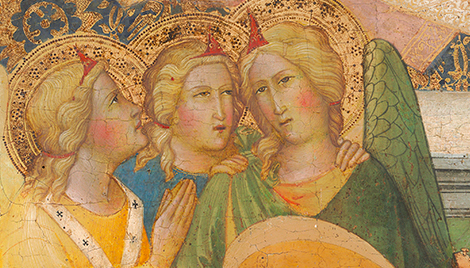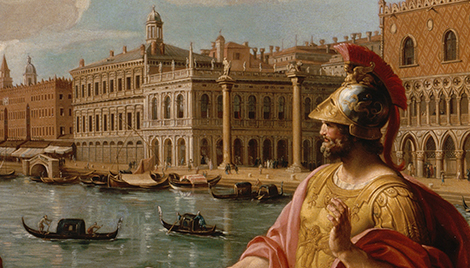Kress Grantee Spotlight: Jennifer Henel
Jennifer Henel is an independent consultant and developer in the digital humanities and serves as the managing editor for the Journal of Historians of Netherlandish Art. She has worked with a number of public and private collections and scholarly digital publications, including more than 15 years at the National Gallery of Art and several years with The Leiden Collection. Ms. Henel serves as the Vice President for Communications with the Digital Art History Society and has published on art historical scholarship in the digital age, including Carrie Anderson and Marsley Kehoe’s Dutch Textile Trade Project ; Dipti Khera's The Place of Many Moods IIIF companion to her book, as well as the National Gallery of Art's inaugural Online Editions' Dutch Paintings of the Seventeenth Century (launched 2014) and The Leiden Collection Catalogue (launched 2017). She holds a B.A. from the College of William and Mary, and an M.A. from The George Washington University.
Read on to hear more about Jennifer's work in digital art history, in conversation with Shea Spiller from the Kress Foundation.
Shea Spiller: Thank you so much for speaking with me today. To kick us off, can you tell me about your role at the Journal of Historians of Netherlandish Art and your other work in the digital humanities?
Jennifer Henel: I am the Managing Editor of the Journal of Historians of Netherlandish Art (JHNA), which is a twice annual publication focused on the study of fourteenth- to eighteenth-century Dutch and Flemish art. Our Editor-in-Chief, Perry Chapman, is a well-respected scholar in the field and we have an editorial board comprised of a host of other scholars. I have a master’s in art history, but my professional background is more in the digital humanities, so I come at it a little differently. It's been nice to be able to float in-between those two spaces.
JH: As an independent consultant, I work with a number of folks. One of the more recent scholars I’ve worked with is Dipti Khera, a scholar and professor based at Colombia University. We’re building out a companion website to her book that will allow for a user to see the entirety of this eighteenth-century scroll end-to-end, using some of the same functionality that we use at JHNA. I'm also collaborating in a couple of spaces with other consulting groups, Design for Context is one and they've done a lot of work within the digital humanities and art history spaces.
It’s really nice to have the consistency of the journal with a more publishing mindset, while exploring more experimental ways to push the boundaries of my work with other projects.
SS: How did you become interested in focusing on the digital humanities and digital art history?
JH: It was somewhat by happenstance. I was working at the National Gallery of Art in DC in the Northern Baroque paintings department while I was finishing my master’s degree. During my time there, we began working on an online catalog that was a Getty Foundation-funded initiative with the proviso that it reexamines the ways that we approach collection catalogues. The scope for our project was taking the online systematic catalog of the National Gallery of Art’s Dutch paintings that was published in 1995 and, rather than making it a scanned PDF, trying to think through questions like: How do people access content? How do we cite things? How do we present this information to the public? How do we make very scholarly information more accessible to a broader community?
There was a lot of change in the field over the course of the five years that I worked on that project and that was a moment when digital humanities really started to gain traction. During that time there was a real sea change in terms of how we approach content and that project was a catalyst for me in getting engaged with other people to further explore the digital humanities. And that really just kept running, that’s also been part of the Digital Art History Society, which is a Kress project as well. I kind of stumbled into this field at a time when there just started to be traction around it, and fifteen years later it has become more mainstream so to speak.
National Gallery of Art, Dutch Paintings of the Seventeenth Century Online Editions
SS: That sounds like such an interesting and exciting time to be coming to this kind of work. And can you tell me more about the Digital Art History Society?
JH: Yes, I am the VP for communications there and I took on the website as part of my consulting work. I collaborated with Morgan Schwartz, who is a freelance developer (with Satellite Jones), I’ve also worked with at JHNA and the Dutch Textile Trade Project. He's a great partner in this because I think he is now more up to speed on the art history side of things, and he was my main partner on building out the Digital Art History Society site. We're now entering into a maintenance phase of being able to adjust some things now that we've been up and live for over a year, so that's been really fortunate. Overall, it’s been a nice and fruitful project to be engaged with.
SS: I'd love to hear more about the Dutch Textile Trade Project, which was funded by Kress. How did you become involved in that project and what were some of its highlights?
JH: I came to the project through JHNA. The scope really changed during the process and it shifted from being, simply put, a satellite database that was part of JHNA to a standalone site with the idea that it can be continually added to over time as expertise evolves and more scholars contribute. That was where the Kress grant was absolutely instrumental. Working with Carrie Anderson and Marsley Kehoe, early on we worked through a system of requirements and the core of what was driving their content. Then we applied for the grant and that facilitated us in being able to do the hard scale development work. We had an initial set of ten textiles to present and, together, we worked through the desired look and feel of the content, and how we wanted the relational database to behave. The engagement with Carrie and Marsley was just awesome. They were such fun partners to work with.
SS: And it’s such a great site and tool. I've spent some time on it and, I'm not a Dutch art historian or a textile historian, but it's just so usable and really conveys information in a way that I’d imagine is both helpful to experts and novice users.
JH: They know that most people are not experts in textiles, right? I think we were able to expand the audience by tying that art historical information to the economic history, for example, and going beyond one perspective or one type of data.
Data Visualization and Visual Textile Glossary entry for chintz/kalamkari
SS: It seems like it could be a great model to use for other similar explorations. I’m sure there are so many different periods in art history that would benefit from that kind of material and economic data analysis.
JH: I completely agree. Even though the development of this project was obviously content specific, I do think there are a lot of pieces in the framework, certainly on the back end and how we have engineered it, that would make it such that it could be a repeatable process and structure to approach other types of content. If you look at any other digital art history projects, you’ll see how they build on one another in these really lovely ways.
SS: What is one of the ways that you think the field of art history can really benefit from the increased incorporation of digital humanities methods and tools?
JH: I think that going into a project with a willingness to make it digitally born and moving away from the requirement of print is key. One of the ways I can see a real benefit out of engaging with digital, even if you don’t know what you want to do with your content, is structuring it in a way that is somewhat clean and fielded, whether it’s a narrative, tombstone data, et cetera. That is a foundational piece of allowing for exponential fun things and innovative tools to come out of your work because you’ll already have something very flexible to take and pour into whatever system that you might want with relatively limited effort.
Another Kress project I worked on when I was at the National Gallery of Art was for the Archive. We basically digitized all of their archival documents and restructured their relational database by cleaning all of the data and then loading that back in. Those paintings have been written about for centuries and we have so much information on them. So I think that, again, that promise of what new things can we discover in art history is really in being able to use these digital tools to look at and think about information in new ways. We won't necessarily find anything new if we just keep doing the same things we've been doing. You know what I mean? That’s where I think Kress has been a leader in funding projects that push the boundaries on what we can do.
A lot of where we are right now is in laying the foundation before we can do any of the really explosive work that’s possible. Getting this structure in place now is like the Toyota Corolla of digital art history, and eventually we’ll get to the Tesla, but it’s not there yet.
SS: That’s a perfect segue to my last question. What makes you most excited to be working in this field right now and in looking towards the future?
JH: I remember hearing about controlled vocabularies and taxonomies from Neal Johnson, my former colleague at the National Gallery who is now at the Getty. And when we were working on the Dutch collection catalogue it was mind-blowing because we were able to think, alright, if I'm able to put these pieces together you’re able to see all these things you couldn't see before. In thinking ahead to the Tesla version of digital art history, to me it’s a universe where we have enough structured data to triangulate things that we haven't always put together. That's where new patterns and trends will emerge that we can then look at predictively for what the future may hold.
Even in this project that Carrie and Marsley did, their production of that database was based on pulling together information from all these different sources and, once you pull that seemingly disparate data together, that’s when you can see so many patterns that otherwise you may not come to. And I think that’s the promise of having nice, structured data where we can allow people to explore through all these different models. That’s what makes me so excited; the possibilities are really limitless. And we can take little pieces from these very specific projects to get us there… that will change how we do art history. And that's and that to me is super exciting, not just for art history, but for the digital humanities in general.
SS: That’s incredibly exciting. Thank you so much! You’re the first “digital art history person” I’ve spoken with as part of this series, so thank you for taking the time to dive into this topic with me.
JH: Thank you! So many of the projects I’ve been able to work on have been very much thanks to Kress, so I’m really grateful for the continued support and for the opportunity to share out on some of those projects.



